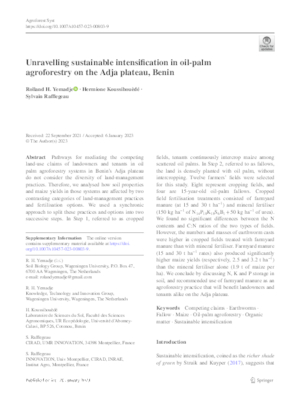Unravelling sustainable intensification in oil‑palm agroforestry on the Adja plateau, Benin
Abstract Pathways for mediating the competing
land-use claims of landowners and tenants in oil
palm agroforestry systems in Benin’s Adja plateau
do not consider the diversity of land-management
practices. Therefore, we analysed how soil properties
and maize yields in those systems are affected by two
contrasting categories of land-management practices
and fertilisation options. We used a synchronic
approach to split these practices and options into two
successive steps. In Step 1, referred to as cropped
fields, tenants continuously intercrop maize among
scattered oil palms. In Step 2, referred to as fallows,
the land is densely planted with oil palm, without
intercropping. Twelve farmers’ fields were selected
for this study. Eight represent cropping fields, and
four are 15-year-old oil-palm fallows. Cropped
field fertilisation treatments consisted of farmyard
manure (at 15 and 30 t ha−
1) and mineral fertiliser
(150 kg ha−
1 of N14P18K18S6B1
+ 50 kg ha−
1 of urea).
We found no significant differences between the N
contents and C:N ratios of the two types of fields.
However, the numbers and masses of earthworm casts
were higher in cropped fields treated with farmyard
manure than with mineral fertiliser. Farmyard manure
(15 and 30 t ha−
1 rates) also produced significantly
higher maize yields (respectively, 2.5 and 3.2 t ha−
1)
than the mineral fertiliser alone (1.9 t of maize per
ha). We conclude by discussing N, K and P storage in
soil, and recommended use of farmyard manure as an
agroforestry practice that will benefit landowners and
tenants alike on the Adja plateau.

